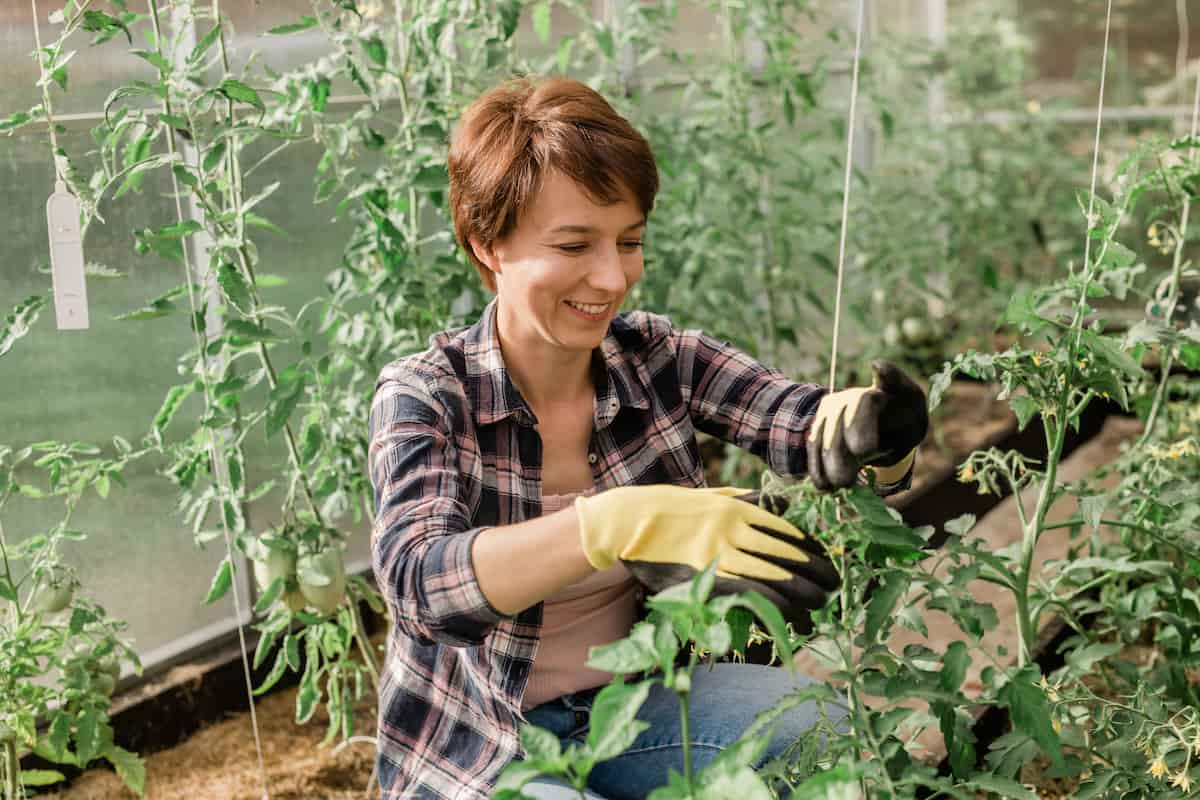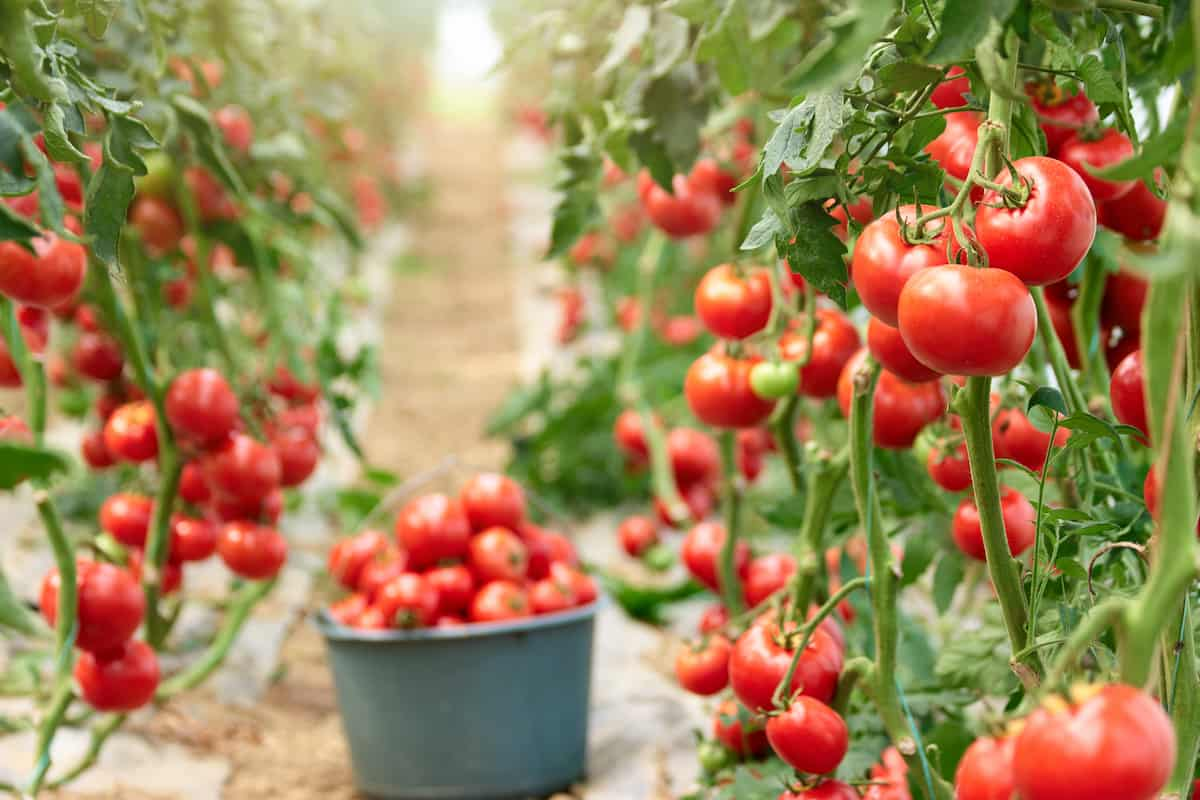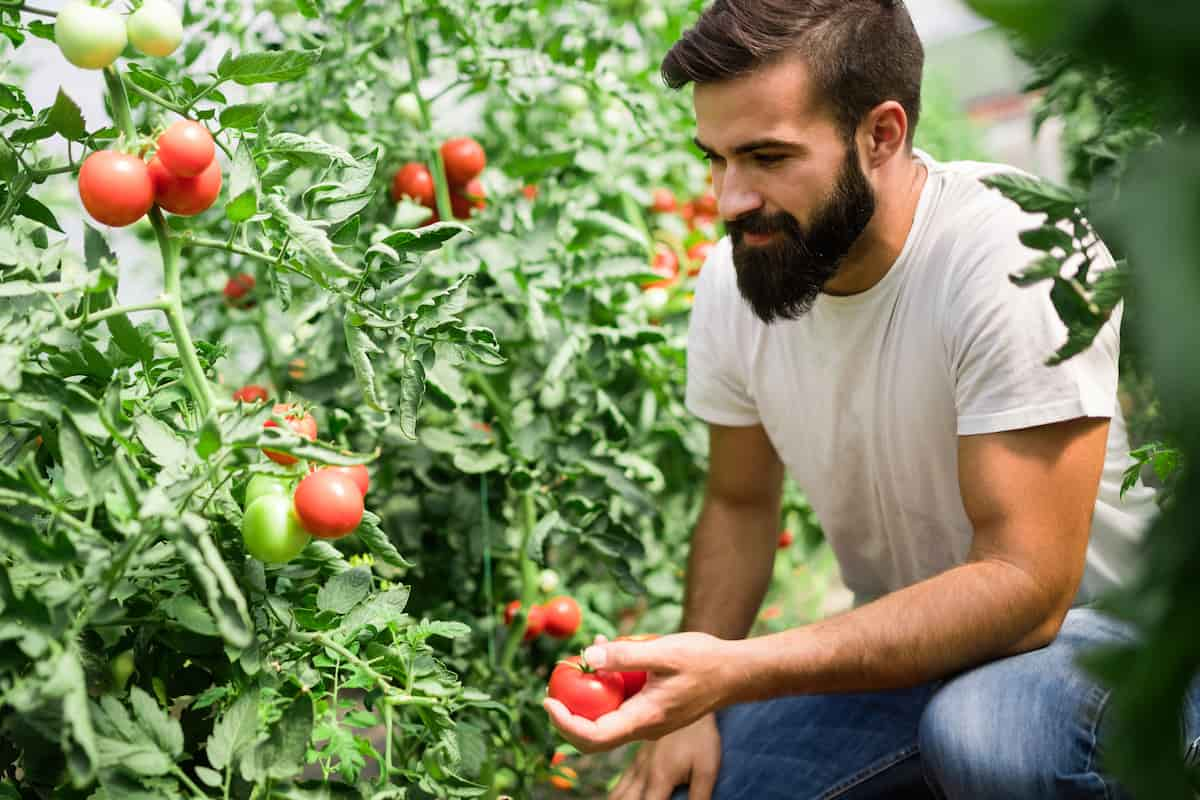There is no greenhouse crop more popular than tomatoes. In most areas of the world, greenhouse growers can produce two tomato crops yearly with good temperature control and plenty of light. Protecting the flowers from disease and successfully pollinating them indoors is more important in these conditions.

How to Grow Greenhouse Tomatoes
Best Tomato Varieties to Grow in Greenhouses
Bush-type and indeterminate tomato plants are the two main types. The best tomatoes for growing in your greenhouse will depend on the size of your greenhouse. If your greenhouse is small, you may want to choose a smaller tomato variety like these.
- Sungold: Indeterminate growth with orange-colored fruit up to 2.5 cm in diameter. A delicious, tangy fruit that can be eaten fresh or dried. Ideally, space them 60 to 100 cm apart.
- Black Cherry: It is a sweet, less acidic, indeterminate tomato. It produces ripe fruits that range from red to purple-black. Ideally, they should be spaced 90 cm apart. It is resistant to many fungus-based leaf diseases.
- Cappricia: Oval-shaped fruit with a sweet, slightly acidic taste. When ripe, the fruit weighs between 14 and 20 grams. Plants that grow indeterminately and can be spaced just 50 cm apart.
- Brandywine: Fruits are large, red, sweet, and slightly acidic due to vigorous indeterminate growth. It is necessary to provide plenty of space for plants since they can grow taller than 2 meters. This variety is preferred for its flavor, but it can also be more susceptible to disease.
- Beefsteak: It is an indeterminate hybrid variety that produces large, fleshy fruits. It takes around 85 days from sowing for plants to reach a height of more than 2 meters.
Soil Requirements for Growing Tomatoes in Greenhouse
In general, tomatoes grow best in well-draining soil mixed with perlite, vermiculite, or sphagnum peat moss. It is a good idea to mix in organic matter before planting, such as compost, because they are heavy feeders.
Temperature and Humidity Requirements for Growing Tomatoes in Greenhouse
- Temperatures between 21°C and 27°C during the daytime and 16°C and 18°C during the night are ideal for tomato growth. Before you plant, ensure your greenhouse maintains these temperatures for several months.
- On overcast days, bring temperatures to the lower end of this range and raise them to the upper end (or even slightly higher) on sunny days.
- Additionally, you need to maintain a humidity level below 90% to avoid excessive leaf mold. Especially on cold, cloudy mornings, ensure the greenhouse is ventilated regularly so fresh, dry air can be brought into the building.
Light Requirements for Growing Tomatoes in Greenhouse
Approximately eight hours of sunlight per day are required for tomato plants. It is an advantage of polycarbonate that it allows adequate sunlight to reach your plants. A hot day usually causes tomato plants to curl their leaves. This isn’t a sign of illness or distress. Early in the morning, wilting leaves indicate the plants need deep watering.
In case you missed it: Frequently Asked Questions About Tomato Farming

Planting Tomatoes in A Greenhouse
- Ensure that the soil is well-draining and nutrient-rich.
- Plant your young tomato plant deep enough in the soil to cover at least 2/3 of the plant or up to the second set of true leaves. Any leaves below the soil’s surface should be pruned off. A tomato plant’s stem will sprout roots below the soil surface to promote strong and vigorous growth.
- If you’re planting in pots or small beds, fill the containers two to three centimeters below the lip. This way, you will ensure that no soil spills when you water.
- After planting, your soil should be completely saturated with water. Afterward, allow your soil to dry so you can feel moisture 1 or 2 centimeters below the surface. Establish your watering regime based on the plants’ requirements.
- When temperatures are kept within an optimal range, plants can grow faster, resulting in greater consumption of water and nutrients. Watch the moisture level in your soil, and look for signs the plants will give you to tell if you are overfeeding or underfeeding.
Fertilizing Greenhouse Tomatoes
As a heavy consumer of nutrients, tomatoes in a greenhouse are no exception. Phosphorus increases the production of flowers and fruit in plants, while potassium aids in their growth. The growth of lush foliage will be facilitated by excessive nitrogen, but the foliage will be softer and more susceptible to fungal leaf diseases. Your plants will receive the right nutrition if you prepare the soil with good-quality compost and manure.
Water Your Greenhouse Tomato Plants
Maintain a regular watering schedule when growing tomatoes in a greenhouse to keep your plants healthy and prevent disease. Besides ensuring a bountiful crop, proper watering also reduces drought stress and overwatering. Tomato plants should not be watered from above. Instead, install a drip irrigation system or water at ground level. Keep an eye on the soil’s moisture regularly. When the soil’s top 2 inches feels moist, wait a day or two before watering. When it’s dry, water immediately.
Pruning Tomato Plants Growing in Greenhouse
- The main purpose of pruning is to ensure your plants are stronger and bear bigger fruits by removing suckers growing on the main stems. Through regular pruning, tomato plants focus their vigor on fruit production.
- Cut off the tips of the main stems of semi-determinate tomato varieties when they reach the top of their support stakes. The tip of two leaves above the topmost flower truss should be cut off.
- You should remove leaves and branches from the bottom 30 cm of your plants as they grow taller. By doing this, you will prevent soil-borne diseases and pests.
Pest and Disease Control for Greenhouse-Grown Tomatoes
- Ensure your greenhouse is properly ventilated to keep pests and diseases at bay.
- For pest and root disease prevention, replace old soil or practice crop rotation before planting another batch of tomatoes.
- Moisture in the soil should be maintained, but over-watering may encourage the spread of fungus and disease.
- When wet, the tomato plant’s leaves are susceptible to disease, so do not install an overhead irrigation system.
- You can increase airflow and sunlight by pruning dead or dying leaves.
Harvesting Your Greenhouse-Grown Tomatoes
The first fruits start to mature after months of carefully managing your tomato plants. Tomatoes can be harvested whenever they are ripe, depending on how much you want. The longer tomatoes stay on the vine, the more red and full they will be. You can either pull the tomatoes off the vine or cut them off with garden pruners. If you leave harvested tomatoes in a sunny spot, they will rot before you can eat them.
In case you missed it: How to Grow Onions in Greenhouse: A Step-By-Step Guide for Seed to Harvest

Conclusion
To conclude, it is quite straightforward to grow tomatoes. There is no point in throwing seeds in the ground and waiting for juicy tomatoes to grow. Make sure you get the hang of it since tomato plants need attention, especially during winter. Planting greenhouse tomatoes at different times of the year will ensure that you enjoy tomatoes all year.
- Feed Your Flock for Less: Top 10 Tips to Save on Chicken Feed
- Ultimate Guide to Ossabaw Island Hog: Breeding, Raising, Diet, and Care
- Hatching Answers: The Top 10 Reasons Your Chickens Aren’t Laying Eggs
- Eggs and Economics: Breaking Down the Cost of Raising Backyard Chickens
- Defend Your Greens: Proven Methods to Keep Iguanas Out of Your Garden
- Ultimate Guide to Cinnamon Queen Chicken: A Comprehensive Guide for Beginners
- Ultimate Guide to California Tan Chicken: Breeding, Raising, Diet, Egg-Production and Care
- Ultimate Guide to Marsh Daisy Chicken: Breeding, Raising, Diet, and Care
- 10 Types of Chicken Farming Businesses You Can Start for Profits